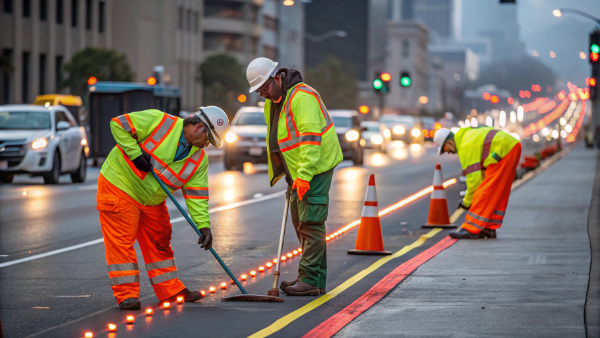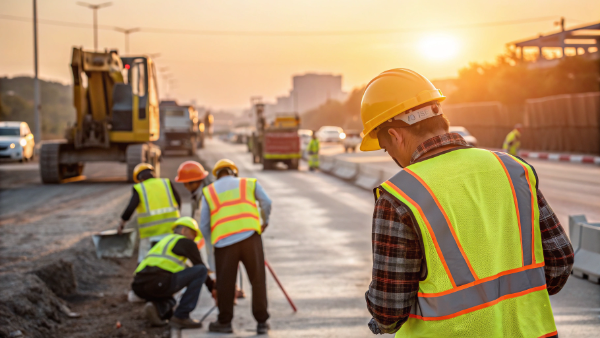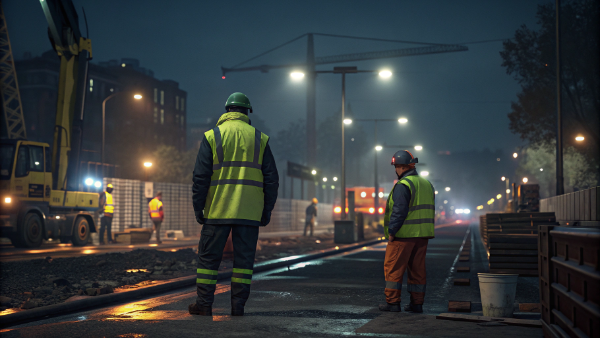Are your workers hard to see in low light or bad weather? This puts them in danger and your company at risk. We provide certified apparel to keep them safe.
High visibility clothing, or hi-vis, is special apparel made with bright fluorescent colors and reflective materials. It ensures workers are easily seen by drivers in low light, significantly reducing accident risks and ensuring worksite compliance. We manufacture these essential safety garments to protect your team.
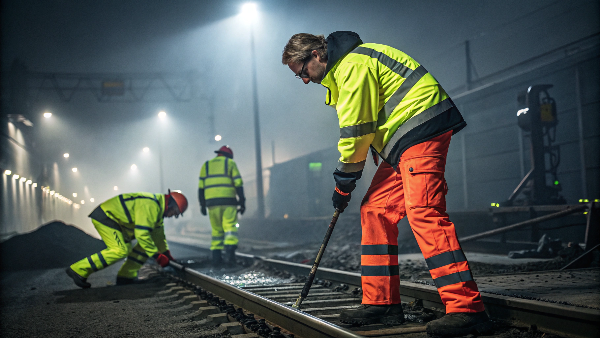
Keeping your team safe is your number one job. But understanding all the rules for hi-vis gear can be confusing. It is important to know what makes this clothing work. This knowledge helps you choose the right products for your workers. Let's break down the details so you can make the best choice.
How does high-visibility clothing work?
Do you just trust that bright colors work without knowing why? This lack of understanding can lead to poor gear choices. We can explain the simple science behind safety.
Hi-vis clothing works in two ways. The fluorescent fabric1 absorbs invisible UV light2 and re-emits it as visible light, making you look brighter in the daytime. The retroreflective tape3 bounces light from headlights directly back to the driver at night.
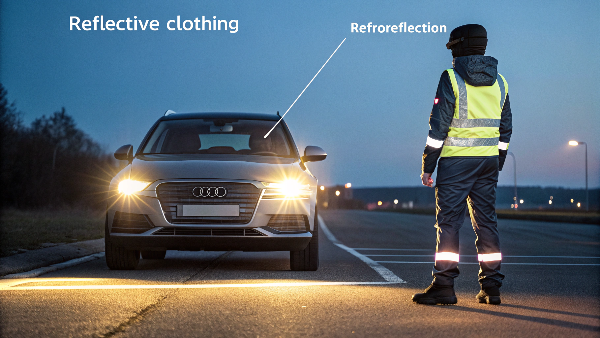
The science behind high-visibility clothing is simple but very effective. It uses two different physical principles to trick the human eye and grab a driver's attention. One method works with the sun's light, and the other works with artificial light from vehicles.
Daytime vs. Nighttime Science
During the day, fluorescent materials appear to glow. This is not just because they are a bright color. These special fabrics absorb ultraviolet (UV) light, which is invisible to our eyes. They then convert that energy and release it as longer-wavelength visible light. This process makes the clothing look much brighter than its surroundings, especially at dawn and dusk when UV light is plentiful. At night, a different technology takes over. Retroreflective tape is covered in tiny glass beads or microprisms. When a car's headlight beam hits this tape, the beads or prisms bounce the light directly back to the driver's eyes. This makes the wearer appear brightly lit, giving the driver critical time to react. Our R&D team is always exploring new materials to improve this effect, creating safer and more reliable products.
| Condition | Primary Mechanism | How It Works |
|---|---|---|
| Daytime / Overcast | Fluorescence | Converts invisible UV light from the sun into visible light, making the garment "glow." |
| Nighttime / Low Light | Retroreflection | Bounces light from a source (e.g., headlights) directly back to the source's origin. |
What are the three classes of high-visibility clothing?
Are you unsure which class of hi-vis gear your team needs? Making the wrong choice can result in non-compliance and put your workers in unnecessary danger. We can clarify the classes for you.
The ANSI/ISEA 1074 standard defines three classes based on the minimum amount of background and reflective material5. Class 1 is for low-risk areas, Class 2 is for moderate risk, and Class 33 offers maximum visibility for high-risk zones.
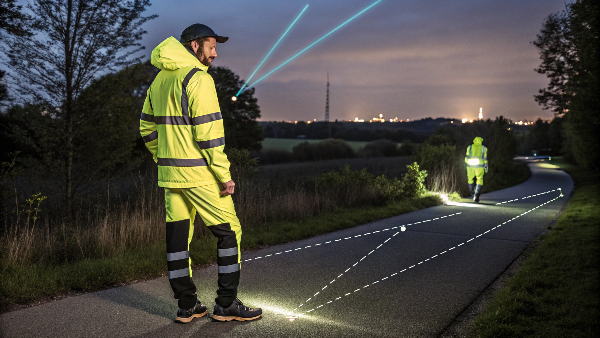
Choosing the right class of hi-vis apparel is not a suggestion; it's a requirement based on the work environment. The American National Standard for High-Visibility Safety Apparel (ANSI/ISEA 1074) creates these classes to match the level of protection to the level of risk. Each class has specific minimum requirements for the surface area of both the fluorescent background material and the retroreflective tape.
Understanding ANSI/ISEA 1074 Classes
The main difference between the classes is the amount of visible material on the garment. More material means more visibility from greater distances and at higher speeds. Class 36 is the highest level and often requires sleeves and full-length trousers to meet the surface area requirements. As a manufacturer for global clients, we produce garments that meet all three classes. For our long-term partner Danny, who supplies to construction and logistics firms in North America, we focus on producing certified Class 2 and Class 36 apparel. Our triple-inspection process guarantees every garment we ship meets these exact material measurements, eliminating compliance risks for our partners.
| Class | Minimum Background Material | Minimum Reflective Material | Intended Use & Environment |
|---|---|---|---|
| Class 1 | 217 sq. in. | 155 sq. in. | Low traffic, speeds under 25 mph. E.g., parking lot attendants. |
| Class 2 | 775 sq. in. | 201 sq. in. | Roadways with speeds over 25 mph, poor weather. E.g., road construction workers. |
| Class 36 | 1240 sq. in. | 310 sq. in. | High-speed traffic (>50 mph), complex backgrounds, very low light. E.g., highway workers. |
How do you recognize high-quality high-visibility clothing?
Are you worried that your hi-vis gear will fail? Cheap apparel fades, tears, and loses its reflectivity, putting workers at risk. Learn how to identify quality that protects.
Look for strong, reinforced stitching, durable fabric, and clear certification labels (like ANSI/ISEA 107). Quality gear keeps its bright color and reflectivity after many washes. We build our apparel to last, with quality checks at every step.

Not all high-visibility clothing is created equal. A cheap vest might look bright on the shelf, but it can quickly fail in the field. True quality comes from the materials used and the way the garment is constructed. Investing in high-quality gear is an investment in your workers' safety and your company's reputation.
Key Markers of Quality and Durability
There are several things to check for when you are buying hi-vis apparel. You should inspect the fabric, the stitching, the reflective tape, and the labels. A client of ours once lost a significant amount of money with another supplier due to poor quality control. That experience reinforces our commitment to a triple-inspection system. We check materials before production, during the sewing process, and before shipment. This ensures every piece of clothing meets our standards for durability and safety. Our certifications, including ISO, OEKO-TEX, and BSCI, are not just logos on a tag. They are a guarantee to our clients that they are receiving a product they can trust.
| Quality Indicator | What to Look For | Why It Matters for Safety and Value |
|---|---|---|
| Fabric Durability | Thick, tear-resistant polyester. Look for a high denier rating. | The garment must survive daily wear and tear in rough work environments without ripping. |
| Stitching Quality | Double stitching and bar tacks at stress points (like pockets). | Prevents seams from splitting under pressure, which extends the garment's useful life. |
| Colorfastness | Fabric that is rated to resist fading from sunlight and washing. | Faded colors are less visible in the daytime and make your team look unprofessional. |
| Reflective Tape | Certified tape that remains reflective after washing and does not crack. | Damaged or weak tape is a major safety hazard, as it fails to reflect light at night. |
| Certifications | Labels that clearly state compliance with ANSI/ISEA 107 or EN ISO 20471. | This is your only proof that the garment has been tested and meets legal safety requirements. |
Conclusion
High visibility clothing is critical safety equipment, not just a uniform. Understanding its components, classes, and quality markers helps you protect your team. We are here to provide reliable solutions.
-
Understanding fluorescent fabric can help you choose the right safety gear for better visibility. ↩
-
Discover the role of UV light in making high-visibility clothing effective during the day. ↩
-
Learn how retroreflective tape works to improve nighttime visibility and safety for wearers. ↩ ↩
-
Explore this link to understand the ANSI/ISEA 107 standard, which is crucial for ensuring safety in various work environments. ↩ ↩ ↩
-
Discover the different types of reflective materials used in high-visibility clothing to enhance safety and compliance. ↩
-
Learn about Class 3 specifications to ensure maximum visibility and safety for workers in high-risk environments. ↩ ↩ ↩

